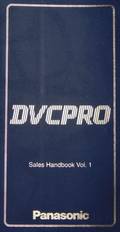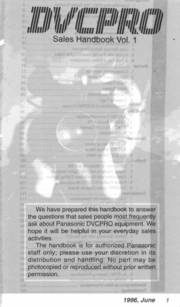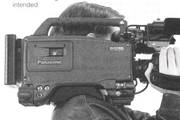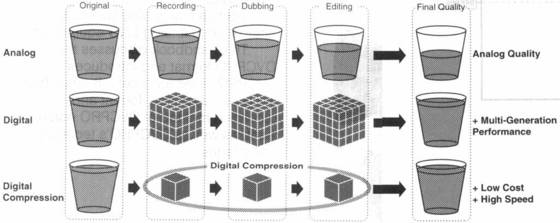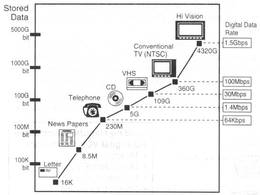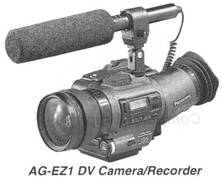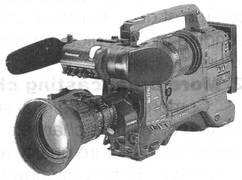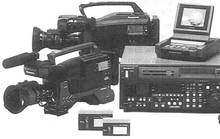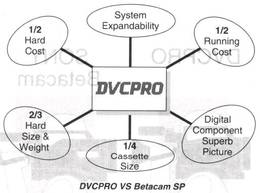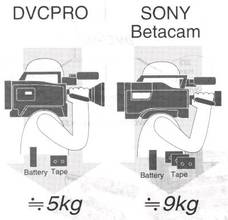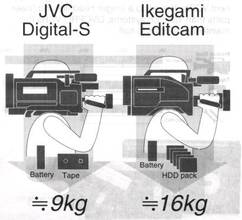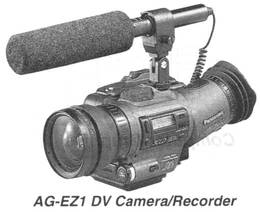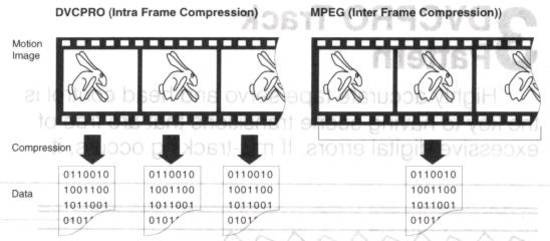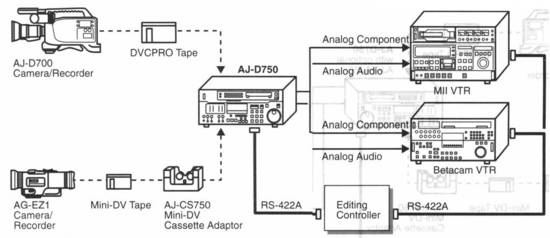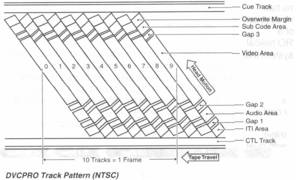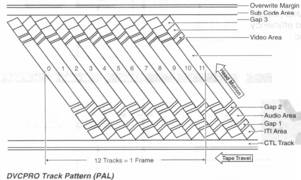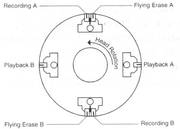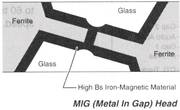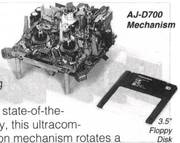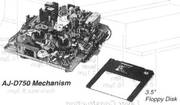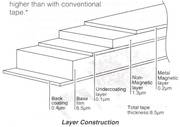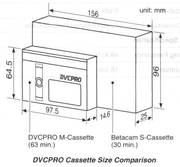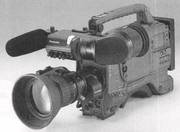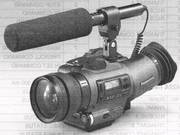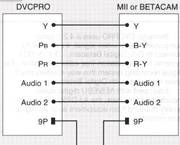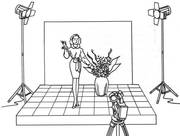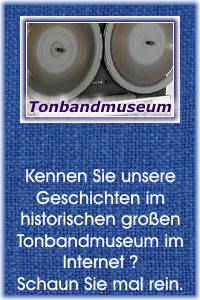Dieses "DVCPRO Sales Handbook" aus 1996 ist ein Prospekt
.... und dieses Prospekt kommt natürlich vom Erfinder bzw. Konstrukteur der DVCPRO Kassette, der japanischen Firma Panasonic, einer Tochterfirma von Matsushita. Deshalb sind manche (eigenen) Lobhudeleien mit Bedacht zu lesen. Auch die Vergleiche und Gegenüberstellungen der bereits vorhandenen Magnetband-Systeme sind recht einseitig aufgehübscht. Der Informationsgehalt dieser Panasonic Firmenbroschüre liegt darin, daß die technischen Daten wie die Bandbreiten der Video-Streams und die Kompressions-gewinne nocheinmal deutlich aufgeführt sind.
.
DVCPRO Sales Handbook Vol.1 - June 1996
We have prepared this handbook to answer the questions that sales people most frequently ask about Panasonic DVCPRO equipment. We hope it will be helpful in your everyday sales activities.
The handbook is for authorized Panasonic staff only; please use your discretion in its distribution and handling.
Inhalt :
.
- Background ................................................................3
1. Cost-Effective ENG: The Digital Solution.....................4
2. From Analog to Digital.............................................6
3. Digital Compression Meets Today's Needs..................8
4. DVCPROandDV ......................................................10 - Concept.......................................................................11
1. That equipment is here today.................................12
2. Smaller Size, Lighter Weight ..................................14
3. Dramatically Lower Costs.......................................16
4. Less Storage Space Required.................................17
5. In Line with Trends toward Digital Video ..................18
6. A New Era of Video Journalism ..............................20 - Format.......................................................................21
1. Compression Methods ..........................................22
2. Compression System ............................................24
3. Track Pattern ........................................................26
4. Head System ........................................................28
5. Compact Mechanism.............................................29
6. Cassette Tape .....................................................30
7. Specifications of DVCPRO Format ........................32 - Products .................................................................33
1. AJ-D700 Camera/Recorder....................................34
2. AJ-D750 Studio VTR.............................................42
3. AJ-EZ1 Mini-DV Camera.......................................48
4. Future Models......................................................54 - Operation ................................................................57
ist komplett übergangen - System.......................................................................101
1 Conversion to Betacam and Mil .................................102
2 Digital Interface with D-5/Digital Betacam .................104
3 Connection with Non-Linear Editing System ..............106
4 Future Plan of DVCPRO Broadcasting .......................108
5 DVCPRO Video Capture Board ..................................110 - Comparison ..................................................................111
1 Camera/Recorder Comparison.....................................112
2 Studio VTR Comparison..............................................118
3 Mini-DV Comparison ..................................................124
4 Format Comparison....................................................126 - Demonstration ...............................................................133
1. Preliminary Points .....................................................134
2. Before Shooting with the AJ-D700 ...............................135
3. Before Shooting with the AG-EZ1.................................137
4. Editing Equipment and Materials ................................138 - Maintenance ..................................................................141
auch dieser Abschnitt ist übergangen - Marketing/Up-to-Date Information ....................................151
- Terminology ..................................................................161
.
Background
.
This section discusses the background behind development of the DVCPRO format and explains how DVCPRO compares with the DV consumer video format. The information is presented under three main headings:
- 1. Cost-Effective ENG: The Digital Solution
- 2. From Analog to Digital
- 3. Digital Compression Meets Today's Needs
- 4. DVCPRO and. DV
Cost-Effective ENG: The Digital Solution
In recent years, video equipment for electronic news gathering (ENG) has become increasingly efficient and rugged. And over the last decade, 1/2" equipment has become the standard for ENG crews around the world.
Today, digital technology promises to really accelerate advances in ENG equipment, with even more rugged, exceptionally lightweight gear that consumes less power and delivers a better overall performance.
The foundation for this technology comes from a number of companies who have each worked to develop a digital VCR. Their efforts led to hopes that basic specifications could be established as worldwide standards.
These hopes were realized at the 1994 follow-up to the HD (high definition) Digital VCR Conference, where companies agreed on a single standard for digital VCRs intended.
.
| Comparison Example | Betacam SP | AJ-D700 |
| Operating weight | 15 lbs | 12 lbs |
| Media cost (20 min.) | $8 (oxide) | $8 (metal particle) |
| Equipment cost (US market) | $40,000 | $16,900 |
Matsushita engineers debated whether or not that core technology — which included a compact mechanism, 6.35mm tape (1/4") cassette and a powerful, symmetrical intra-frame compression scheme — could also be applied to professional ENG equipment. They weighed several factors, such as cost-effectiveness, data transfer speeds, packing density and field reliability, and also studied users' nonlinear acquisition needs.
Matsushita concluded that it was indeed possible to develop a cost-effective, digital component, broadcast-quality acquisition format that offered retrieval and transfer at faster than realtime.
In the news gathering field, equipment weight, capital cost, running costs, power consumption, durability, picture quality and features are vital concerns.
With advantages in each of these areas, "DVCPRO" format equipment now represents a highly cost-effective digital alternative to analog ENG equipment.
This handbook discusses the DVCPRO format and introduces DVCPRO video recorders. It describes the goals, evolution, format and recording method of DVCPRO equipment, as well as DVCPRO's technical advantages.
Chapter 2 - From Analog to Digital
Digital recording has proven superior in quality to analog recording, but the digital video formats developed since 1985 have not had a significant impact on ENG. However, the advantages in cost, size and power requirements of equipment that uses these formats now makes them suitable replacements for analog ENG formats.
At the same time, considerable advances have been made in digital post-production capabilities, with nonlinear editing, minimum loss dubbing, and multi-layer effects now possible. Also, digital distribution through wired networks, and new media such as CD-ROMs have heightened demand for digital production.
In July 1993, more than 56 companies (some of which are listed below) attended the HD Digital VCR Conference. They agreed to develop a set of universal specifications for HD digital VCRs, working independently on digital VCRs and related technology.
.
The DVCPRO specifications were finalized in April 1994.
They called for the use of 6.35mm (1/4") tape (with two cassette sizes) to record component digital video data that is sampled at 13.5 MHz and compressed by a "Discrete Cosine Transformation"- based method to achieve a 25 Mb/s video recording rate for both 525/60 and 625/50 systems.
Once agreement was reached on the standard specifications, Matsushita set to work developing integrated circuits that would make the VCR unit as compact as possible while providing powerful digital compression with minimal power consumption.
Improvements in chip density, on-chip functions and boundary scan diagnostics - first introduced in our D5 VCRs — helped cut troubleshooting and re-engineering time.
Our engineers also developed a compact transport that uses a 21.7mm head drum and dual recording heads rotating at 9,000 rpm.
These developments helped achieve the light weight and low power consumption needed in the field.
From the basic compression method, transport design and integrated circuits, it became clear that a cost-effective digital ENG system could be created in the DVCPRO format — and that the equipment could provide advanced functions like frame by frame insert editing and off-speed playback.
.
Leading Manufacturers at the HD Digital VCR Conference
.
- • Hitachi
- • Matsushita Electric
- • Mitsubishi Electric
- • Philips Electronics
- • Sanyo Electric
- • Sharp
- • Sony
- • Thomson Multimedia
- • Toshiba
- • Victor Company of Japan (JVC)
.
Chapter 3 - Digital Compression Meets Today's Needs
A single image contains a large amount of data. In a moving picture - which is made up of 25/30 (NTSC/PAL) image frames per second - the amount of data is enormous. There's also a tremendous amount of digital data in the video signals broadcast by TV stations - more than 1,500 times the data carried by telephone signals, and 72 times as much data as in a CD (per unit of time).
In other words, today's video applications require the processing of an extraordinary amount of data.
.
With our D-3 and D-5 VCRs, Panasonic has succeeded in recording these huge volumes of data, in original form, onto compact, 1/2-inch cassette tapes. These VCRs deliver an outstanding performance in terms of recording fidelity and data storage. In the mean while, compression brings exciting new possibilities to all types of media, from communication and broadcasting to data packaging.
.
- 1. Moving picture data can be transmitted over telephone lines
Today, even with high-speed digital lines such as ISDN, it's simply not feasible to transmit moving picture data over telephone lines. Compression, however, makes this possible by reducing the total volume of data. It also opens up the possibility of sending moving pictures in real-time for the next future. - 2. More broadcasting channels
Compression of digital signals allows broadcasting of multiple channels (the exact number depends on picture quality and compression ratio) in the same bandwidth now used by a single channel with broadcasting of analog signals. The total number of channels available will be increased several times over. - 3. Downsized equipment and lower costs
Data compression allows downsizing of both media (such as cassette tapes) and equipment (such as VCRs). Costs will likewise be lower. The smaller sizes are an advantage in ENG applications, and also mean that less space is required for installation and storage. DVCPRO compresses signals to one-fifth their original size. This allows downsizing and lower costs, while the 25-Mbps data rate is adaptable to future communication and broadcasting networks.
.
Chapter 4 - DV and DVCPRO
At the "HD Digital VCR Conference", standard specifications were adopted for the DV format intended for consumer-use equipment. While DVCPRO adopts some of the same standards, DVCPRO and DV are distinct formats. The differences between them include:
| DV | DVCPRO | |
| Tape Speed | 18.8 mm/sec. | 33.8 mm/sec. |
| Track Pitch | 10um | 18um |
| Cassette Size | Mini-DV/Large | Medium/Large |
| Tape | ME | MP |
| Helical Track | Video Audio Sub | Video Audio Sub |
| Linear Track | - | Cue CTL |
.
CONCEPT
.
Better, Faster, Cheaper
.
- 1. That equipment is here today.
- 2. Smaller Size, Lighter Weight
- 3. Dramatically Lower Costs
- 4. Less Storage Space Required
- 5. In Line with Trends toward Digital Video
- 6. A New Era of Video Journalism
.
1 - That equipment is here today.
DVCPRO is a highly cost-effective solution for digital ENG. Its potentiality is enormous, thanks to a recording method that gives developers new possibilities. With DVCPRO, products such as a compact field recorder/player with built-in LCD monitor, a battery-powered laptop editor with dual VCRs and integral monitoring or 4x speed VCR can become a reality.
And already, ENG editing has become possible at sites never before imaginable.
Background
.
- • Trend toward digital video technology
- • Need for downsizing
- • New era of video journalism
.
The next generation of video equipment must provide more than basic benefits, like easy transfer to nonlinear systems for editing. The new equipment must also provide higher quality and more advanced features while consuming less power-consumption and it must be available at lower costs.
That equipment is here today.
As the world's leading manufacturer of DVCPRO-standard video recording equipment, Panasonic believes that DVCPRO is ushering in a new era of practical and cost-effective digital news gathering.
.
2 - Smaller Size, Lighter Weight
.
While broadcasting camera/recorders continue to improve, recent years have brought no significant reductions in weight. Even with today's mainstay 1/2-inch analog format, heavy cameras are a burden that field operators struggle with every day.
DVCPRO is changing all that. The DVCPRO cassette with 1/4-inch (6.35mm) tape has helped achieve reductions in size and weight that are simply impossible with conventional 1/2-inch systems.
.
The AJ-D700 camera/recorder, for example, weighs only about 5.8 kg in full operating condition (with lens, microphone and battery). Combining digital picture quality with weight and balance that are ideal for ENG, the AJ-D700 brings a whole new level of flexibility to the field.
The DVCPRO cassette is about 1/4 the overall size and 1/6 the weight of current ENG cassettes, yet it provides twice the recording time. The operator needs to take fewer cassettes to the field.
.
3 - Dramatically Lower Costs
Because news gathering consumes a lot of tape, tape cost is an important consideration. In analog systems, for example, metal particle tapes never enjoyed widespread use because of their higher costs. Similarly, high tape costs have been a major drawback with digital camcorders.
DVCPRO is changing this, too, by using a metal particle tape that is less expensive than current 1/2-inch analog metal tapes. In terms of recording time, the DVCPRO cassette tape costs about half as much as current 1/2-inch analog metal tape and 1/4-inch as digital tape. The result is lower operating costs and more freedom in the field.
Likewise, DVCPRO VCRs offer high performance at lower costs than 1/2-inch analog component VCRs. Thanks to a longer head life and fewer parts than 1/2-inch systems, DVCPRO VCRs cut maintenance costs in half.
4 - Less Storage Space Required
On top of advantages in field flexibility and overall costs, DVCPRO offers another key benefit: it requires much less tape storage space.
In operations where news is gathered and broadcast day after day, conventional 1/2-inch analog component tapes start to accumulate and require an enormous storage space. But the downsized dimensions of the DVCPRO cassette mean you can store four times as many tapes in the same shelf space (about eight times of recording time). And since each DVCPRO tape can record twice as long as a 1/2-inch tape, this factor is essentially doubled.
With DVCPRO, archiving becomes easier and much less space-intensive.
5 - In Line with Trends toward Digital Video
Computer technology is creating revolutionary new trends in the video production and broadcasting fields. Non-linear editing, large-capacity video servers, computer graphics, digital data communications — like DVCPRO, these are each based on compressed digital video signals.
While DVCPRO draws on the many advantages of tape media, it adapts well to new digital-based technologies.
.
- Superior Quality: DVCPRO's component digital recording system achieves superb levels of picture and sound quality.
- DVCPRO combines a video band of 5.75 MHz and video S/N ratio of 60dB with two channels of 16-bit PCM digital audio with 48-kHz sampling.
- An error correction function eliminates dropout and burst error. And thanks to a track pitch that's about twice as wide as the DV consumer video format's, DVCPRO assures exceptional recording reliability as well.
- Network Compatibility: DVCPRO compresses signals to 1/5 their original size. With a data rate of 25 Mbps, these digital signals can be sent just as they are or compressed further for linking to a network across digital or analog telephone lines.
- High Speed Transmission to HDD: Matsushita Electric plans to develop a video player that operates at four times normal speed for highspeed transmission.
.
6 - A New Era of Video Journalism
DVCPRO is helping usher in a new era of video journalism, in which a single person carries all the video equipment he or she needs to report a story. Compact, lightweight and cost performance, DVCPRO equipment is the ideal tool for today's video journalists.
For further flexibility the Laptop Editor allows on-site editing, and facilitates transmission of information to a broadcasting station from anywhere in the world.
There are other possibilities, too. The AJ-D750 can play back tapes recorded in DV using the optional AJ-CS750 cassette adaptor. This allows easy use of news events recorded on DV-format equipment, such as Panasonic's AG-EZ1 DV Camera/Recorder or other cameras used by eye witnesses.
.
FORMAT
.
This handbook explains some of the technical aspects of the DVCPRO format, and how it achieves high-density digital recording onto 1/4-inch tape. The information is presented under six main headings:
- 1. Compression Methods
- 2. Compression System
- 3. Track Pattern
- 4. Head System
- 5. Compact Mechanism
- 6. Cassette Tape
- 7. Specifications of DVCPRO Format
.
1 - Compression Methods
.
- 1.DCT using inner-image correlation
In this method, which draws on the closeness in brightness and color between adjacent pixels in an image, DCT (discrete cosine transform) processing assures effective compression. The screen is divided into 8x8-pixel blocks, and DCT processing is applied to each block. Pixel values tend to concentrate in low-frequency areas; quantization of these serves to eliminate the high-frequency pixels, reducing the overall volume of data. - 2.Motion correction using inter-image correlation
Moving pictures are a series of images, each slightly different from the one before. The motion correction method compares the current and previous images. In cases where there is no change (that is, no motion), data from the previous images is used. In cases where change (motion) is detected, only the change data is used. The overall data volume is thus reduced. - 3.Variable-length coding using probability of appearance
In data obtained from either DCT conversion or motion correction, a short code (for example, 1 bit) can be assigned to values that indicate high probability of appearance, and a long code (for example, 8 bits) to those indicating low probability. This data reduction method is known as variable-length coding.
DVCPRO combines all three of these methods. Data compression by motion correction, however, is kept to a minimum, to allow frame-by-frame reproduction of original images. In MPEG, the motion correction is applied over several frames; this results in a higher compression ratio, but problems can arise in frame-by-frame editing.
.
2 - Compression System
DVCPRO is able to read an 8-bit component signal sampled at 13.5 MHz on tape that is only 1/2 the width of original D-1 tape. This is possible because of digital compression. In technical terms, the compression system used by DVCPRO is an intraframe 5:1 discrete cosine transformation of 4:1:1 Y, R-Y, B-Y component signals that retains the 13.5-MHz luminance sample rate.
With 3.375-MHz sampling of the chrominance components, there has been some concern about subjective colour imagery. DVCPRO, however, has demonstrated a chroma performance equal to those in conventional component analog formats. Through chroma sample doubling, DVCPRO's digital inputs and outputs are SMPTE259M-C, 272M (NTSC) /EBU Tech. 3267-E (PAL) serial digital 4:2:2.
.
Die Darstellung der Kompression des Video-Streams
.
DVCPRO's compression is intraframe and field adaptive. The coding system uses feed-forward techniques to achieve fixed-length data packets, and it selects from 16 quantizing tables and two DCT modes for still or motion to deliver an excellent compression performance. (Audio signal is not processed by compression.)
.
3 - DVCPRO Track Pattern
Highly accurate tape servo and head control is the key to having scene transitions that are free of excessive digital errors. If mis-tracking occurs, it can create an "out of format" helical track with a high error rate that causes a disturbance in the picture or at edit points.
.
DVCPRO uses 18-micron tracks, as compared with the 10-micron tracks of the consumer DV format. The wider track results in a higher-quality, editable recording that not only plays reliably, but is also backward compatible with consumer recordings played at 1/2 DVCPRO speed.
.
Track Pattern Diagrams
The DVCPRO track format consists of 4 main data blocks in each track. Longitudinal TC information is put in the subcode block.
.
- ITI: Edit timing and automatic head tracking signals to improve insert editing.
- Subcode: For identifying program type, length, subject, producer and other data as needed. Recorded in a pattern that lets the helical heads read and decode the data during searches at up to 60 times normal playback speed.
.
4 - DVCPRO Head System
The growing popularity of hard-disk-based nonlinear post-production systems has allowed development of a DVCPRO helical head system that is high in quality, inexpensive and easy to service. DVCPRO uses a fixed head, which assures reliable, long-term performance at minimal cost.
The system consists of 6 heads: 2 for recording, 2 for playback and 2 for flying erase. The AJ-D750 studio VTR is equipped with dual codecs, allowing confidence playback of the recorded data.
These are all used simultaneously in the studio VCR for "off speed" playback, which increases the amount of data recovered and thus enables "digital slow motion."
DVCPRO uses a newly developed MIG (metal-in-gap) head that offers the optimal head efficiency required for high-density digital magnetic recording. This advanced head delivers excellent recording and playback thanks to a high-saturation- flux-density magnetic film that is formed in a direction parallel to the head gap.
.
5 - Compact Mechanism
The DVCPRO mechanism is just one-sixth the size of the mechanisms used in conventional studio-type analog component VCRs. Reflecting today's state-of-the-art VTR technology, this ultracompact, high-precision mechanism rotates a Disk 21.7mm-diameter head cylinder at 9,000 rpm.
The tape tension is only 10g. Because there is minimal frictional wear on the heads and head cylinder, the heads last longer and need to be replaced less frequently. There's also minimal dropout, which means less error generation and head clogging.
Durability has also been improved in each component, resulting in a mechanism that delivers higher reliability, longer service life, and lower maintenance costs.
Use of a floating bearing in the head cylinder has enabled a downsized unit and higher rotational speed. The aluminum diecast chassis has proven exceptionally long-lasting and able to resist the effects of environmental change.
.
6 - DVCPR0 Cassette Tape
DVCPRO tape incorporates newly developed ultrafine, high-energy metal magnetic particles that are only one-third the size of particles in conventional tape.*) These particles not only make a thinner magnetic layer possible, they also boast superb magnetic characteristics thanks to Panasonic's original "slanted deposition" technology, which embeds the particles directly into the tape in an extremely dense formation. The result is magnetic energy output that's over 200% higher and C/N characteristics that are 8 dB higher than with conventional tape.*)
*) Compared with the D-3 1/2-inch digital component tape used in Betacam.
.
This high-performance tape supports DVCPRO's high-density digital recording, which delivers exceptional picture and sound quality.
The surface of DVCPRO tape features Panasonic's ultra-flat base film and advanced calendering techniques, eliminates spacey loss and micro-dropouts. Its structure also prevents the permeation of oxide substances. A lubricant is applied to the tape surface, helping assure trouble-free news gathering even in bitter cold and other extreme specified conditions.
These features give the DVCPRO tape an extremely smooth surface, outstanding durability, long shelf life and stable tape transport. This ultra-thin tape is also excellent in high-speed searching.
.
7 - Specifications of DVCPRO Format
| General____________________ | |
| Format | DVCPRO 1/4" Digital component recording |
| Recording Track | |
| Helical Track | Digital Video Digital Audio: 2CH Sub-Code area (Time Code etc.) |
| Linear Track | Cue Audio: 1 Track CTL: 1 Track |
| Tape Speed | 33.813 mm/s (NTSC), 33.847 mm/s (PAL) |
| Max. Recording Time | 63 min. with an AJ-P63MP cassette |
| 123 min. with an AJ-P123LP cassette | |
| Tape | 1/4" Metal Particle Tape |
| Cassette Size M-Cassette: | 3-13/16" x 2-1/2" x 9/16" (97.5x64.5x14.6 mm) |
| Cassette Size L-Cassette: | 4-15/16" x 3x9/16" (125x78x14.6 mm) |
| Video Specification | |
| Sampling Frequency | Y: 13.5MHz C (PB/PR): 3.375MHz |
| Quantization | 8 bits |
| Error Correction | Reed-Solomon Product Code |
| Audio Specification | |
| Sampling Frequency | 48 KHz |
| Quantization | 16 bits |
Products
.
DVCPRO Products Line-Up
- 1. AJ-D700 Camera/Recorder
- 2. AJ-D750 Studio VTR
- 3. AG-EZ1 Mini-DV Camera
- 4. Future Models
.
1 - AJ-D700 3CCD/DVCPR0 Camera/Recorder
.
- AJ-D700 Features
- Integrated Digital Camera/Digital VTR
Digital signal processing in cameras is perfectly coupled with a component digital recording system of astounding efficiency. - Light Weight 5.85-kg
Even in full operating condition — with lens, 1.5" viewfinder, cassette and battery pack — weighs in the 5.85-kg . Thisideal news combination provides good stability on the operator's shoulder, yet doesn't hinder operation. - Low Power Consumption 23W (NTSC) 24W (PAL)
Low Power Consumption and a single Anton/Bauer battery pack supplies satisfactory time for continuousfield operation. The Power Save mode for extended use. - Digital Quality Picture and Sound
Digital component video recording delivers outstandingpicture quality across a 5.75-MHz(Y) video bandwidthand 55 dB (NTSC), 53 dB (PAL) video S/N. 48-kHzsampling 16-bit 2-channel digital audio with 85 dB S/N.Error correction coding, is highly resistant to media variations that cause dropouts. - 63-Minute Recording/Playback
The DVCPRO ENG cassette is only about one quarter the size and one-sixth the weight of the 1/2-inch ENGcassette, yet it allows up to 63 minutes of recording time. - 410,000-Pixel(NTSC)/480,000-Pixel(PAL) 1/2-inch FIT 3CCD
Advanced on-chip lens technology provides low noise high performance in lower light shooting. The camera delivers minimal smear, high-quality pictures and high sensitivity (F8, 2000 lux, 89.9% reflection). - No Playback Adaptor Necessary
Black and white playback on the viewfinder, full color on an external TV monitor allows field check on-site and microwave transmission.
.
- Other Advanced Features
• 26-pin VTR connecter (optional AJ-YA700) allows backup recording in another format VTR.
• Easy set-up, minimum maintenance digital camera processing.
• Digital circuits assure exceptional picture quality: chroma detail, dark detail, 2-dimensional low-pass filter, skin tone detail, masking, auto knee and others.
• Scene File and IC Cards
• One-Touch Camera Status Report
• Programmable One Button Backlight Mode and Super Gain Mode
• Electronic shutter
NTSC: 1/100, 1/120, 1/250, 1/500, 1/1000,1/2000-sec PAL: 1/60, 1/120, 1/250, 1/500, 1/1000,1/2000-sec
• Synchro scan shutter for less flicker shooting of CRT. NTSC: 1/30.4 to 1/57.4 sec, 1/61.7 to 1/250 sec. PAL: 1/29.9 to 1/47.6 sec, 1/51.5 to 1/252 sec.
• 2 Lux Shooting Illumination with F1.4, +30 dB gain-up mode.
• Image S/N ratio: 62 dB (NTSC), 60 dB (PAL).
• Horizontal resolution: 750 lines (center). •Vertical resolution:
NTSC: 400 lines (normal mode)/450 lines (Super V mode). PAL: 450 lines (normal mode)/500 lines (Super V mode).
• Programmable 3 position gain switch, can select from -3,0, +3, +6, +9, +12, +15, +18, +21, +24, +30 dB.
• Auto White Black Balance for each filter (3200K, 5600K+1/4ND, 5600K, 5600K+1/16ND)
•Large, 3-D adjustable 1.5" EVF
• One-touch Rec Review Function.
• Built-in SMPTE(NTSC)/EBU(PAL) Time Code Generator/Reader
• Analog video input (NTSC)/Video Return (PAL) and audio line input (XLR x 2 channels), with optional AJ-YA710 (In PAL input, video signal cannot be recorded).
• Compatible with Anton/Bauer Digital Battery
.
2 - AJ-D750 DVCPRO Studio Recorder
.
- AJ-D750 Features
- Compact 4U Size, Easy Installation
The AJ-D750 fits a 19-inch rack by AJ-MA34H* and installs easily in both the studio and OB van. *Slide-rail, not included. - 123-Minute Recording Capacity
The AJ-D750 accommodates both TV program production and broadcasting needs using the DVCPRO large cassette (AJ-P123L). It also accepts medium DVCPRO cassettes from 6 to 63-minute. Outstanding Picture and Sound Quality Digital component recording assures superb pictures, with a video Y bandwidth of 5.75 MHz and video S/N ratio of 60 dB. Two 16-bit digital audio channels with 48-kHz sampling. It remains high quality even after editing and repeated dubbing. - Playback of DV-Format Recordings
The AJ-D750 can play back tapes recorded in DV, using the optional AJ-CS750 cassette adaptor*. This allows easy use of news events recorded on DV-format equipment by eyewitnesses or others at the scene. - • The AJ-D750 cannot record Mini-DV cassettes even with the AJ-CS750 cassette adaptor.
- Standard Interface
4:2:2 serial digital component (NTSC: SMPTE259M-C / PAL: EBU Tech.3267-E) in/out capability with optional AJ-YA750 board.
• Digital Audio In/Out: AES/EBU digital audio in/out (XLR-3P) terminals.
•Analog In/Out: Component/composite video and analog audio.
• Remote Control: A 9-pin serial (RS-422A) terminal interfaces with virtually all types of editing controllers.
.
- Other Advanced Features
• Built-in SMPTE(NTSC)/EBU(PAL) time code generator and reader
• Digital still and digital slow-motion playback at up to about ±1/2 x normal speed.
• About 60 times normal speed shuttle search, as well as 100 times normal speed FF/REW and Jog.
• Assemble, Insert and audio split editing is possible with the RS-422A interface
• Channel Condition Indication lamps
• Direct-Access Control Panel
• On-Screen Set-Up Display
• Data communication with computers is possible through the RS-232C terminal and 25-pin parallel control terminals, also equipped (software is option).
• Digital Video Controller: The optional Digital Video Encoder Remote Controller, AU-ER65B, enables remote adjustment of up to 4 VTR parameters, such as level, phase and gain.
.
3 - AG-EZ1 3CCD/Mini-DV Camera Recorder
.
- AG-EZ1 Features
- Superb Pictures, DV Digital Recording
8-bit digital compression recording system delivers superior picture quality, with 500-line horizontal resolution and an S/N ratio of 54 dB. The wide colour frequency of 1.5 MHz (NTSC), 3.0 MHz (PAL) reproduces even subtle colour details. - 4 Channel PCM Sound Recording
16-bit digital sound system rivals the quality of CDs.Select between PCM audio of 48 kHz/16 bits (2 channels) and 32 kHz/12 bits (4 channels). Built-in stereomicrophones and also accepts external microphones. - Playback with DVCPRO Equipment
Mini-DV cassettes can be played back in DVCPRO Studio VTR, AJ-D750 by using the optional AJ-CS750 adaptor*, allowing DV cassette use as playback only media in broadcasts. * The adaptor allows playback but not recording. - 3CCD Camera
The 270,000-pixel (NTSC) / 320,000-pixel (PAL) 3CCD is perfectly balanced with the VTR section's outstanding performance, — High S/N ratio, high sensitivity and wide dynamic range. Also, double-density pixel distribution and a gapless dichronic prism ensure sharp images and extremely faithful colors. - Large-Diameter Colour EVF
Equipped with a large (39-mm-diameter), professional-style eye coupler, the viewfinder moves 120 degrees vertically for good visibility even with the eye away from it. The 0.7-inch 180,000-pixel (NTSC) / 166,000-pixel (PAL) color LCD helps assure easy viewing.
.
- Other Advanced Features
.
• 10x optical zoom and a 20x digital zoom with Turbo-Zoom function.
• EIS/Digital Zoom(NTSC)/Digital Image Stabilizer(PAL) corrects jitter to assure clear, shake-free shots.
• Manual focus uses the ring system commonly found in professional equipment.
• Manual iris with a 16-step(NTSC)/13-step(PAL) dial, and AE lock mechanism
• Auto gain and a 5-step (0, +3, +6, +9 and +12 dB) manual gain-up function.
• High Quality Playback without the need for a playback adaptor.
• Professional Option: high-precision, minimal-distortion wide conversion lens and high-performance microphone
• Digital Photo Shot button records a high-quality still image.
• 14-step electronic shutter NTSC: 1/50 to 1/8,000-sec/PAL: 1/60 to 1/8,000-sec
• Automatic high-speed search of blank sections and sections where the recording date has changed
• Digital search at 10x normal speed; cue and review at 60x
• Frame-by-frame recording of high-quality still images, at 1/30-second(NTSC) or 1/25-second(PAL) per frame
• 4-Mode white balance including auto setting, Indoor, Outdoor and manual setting
.
Operation lassen wir aus !!!!!
.
SYSTEM
.
.
This section discusses typical interfaces for connecting DVCPRO equipment with analog VTRs, digital VTRs and computer-based systems.
- 1 Analog System with Mli and Betacam
- 2 Digital interface with D-5/Digital Betacam
- 3 For Non-Linear Editing System
- 4 Future Plan of DVCPRO Broadcasting
.
1 - Conversion to MII or Betacam
While DVCPRO uses a digital component recording system, it can also output high-quality analog component signals (Y/Pb/Pr). The standard RS-422A (9-pin) remote interface allows connection with various types of editing controllers, as well as direct connection with the widely used MII or Betacam editing systems.
You can upgrade to an all-digital system one step at a time. For example, you could first upgrade to a digital camera/recorder and editing player, then later add a digital VTR and switcher. There's no need to incur the expense (and suffer the downtime and inconvenience) of replacing all equipment at once.
The AJ-D750 comes equipped for analog composite signal input and output, so it can be flexibly configured in systems with either analog VTRs (such as S-VHS and Hi-8 systems) or digital VTRs (such as D-3 and D-2).
.
2 - Digital Interface to D-5 or Digital Betacam
Because DVCPRO uses a 4:2:2 serial component digital video signal, it can directly connect to D-5, Digital Betacam, D-1, or DCT systems for degradation-free editing. Addition of a digital recording system this way involves much lower costs than with Digital Betacam.
Equipped with AES/EBU digital audio input/output terminals, the AJ-D750 allows high-quality dubbing from equipment such as digital tape recorders.
.
3 - Connection with Non-Linear Editing Systems
Like conventional VTRs, the AJ-D750 can connect via analog input and output terminals to non-linear editing systems (such as the Post Box, the AVID News Cutter) and hard disk media (such as video servers) for dubbing.
However, both DVCPRO and MPEG use digital compression, and it's not practical to convert digital signals to analog (this can also degrade picture quality). This has led Panasonic to begin developing equipment based on a new concept. Examples include option boards that support interfacing using the original 4:2:2 digital signals (or even using the original compressed DVCPRO signals of MPEG media), and players that transfer data from DVCPRO tapes to hard disks at four times normal speed.
These devices will allow configuration of total systems that let users take best advantage of the distinct features of the tape and hard disk.
.
4 - Future Systems (Tentative)
.
5 - DVCPRO Video Capture Board
.
- Bridge between 2 worlds -
Future developments will make it possible to edit materials at the recording site and transmit them to the broadcasting station over telephone lines or via communication satellite. Incoming news sources will be loaded onto a server at four times normal speed, where they can later be accessed from multiple non-linear editing systems connected to the station's LAN. And use of DVCPRO carts for archiving broadcast programs will provide storage of huge amounts of data at very low costs.
.
COMPARISON
.
This section compares the performance and functions of DVCPRO equipment with conventional models and rival products. (Data shown for rival products is from their announced figures at the time this handbook went to press; actual values may differ.)
.
- 1. Camera/Recorder Comparison
- with Betacam
- with Digital Betacam
- with MII/S-VHS - 2. Studio VTR Comparison
- with Betacam -with Ml I
- with Digital-S - 3. Mini-DV Comparison
- 4. Format Comparison
- with D-5/Digital Betacam
- with Consumer's DV
- with Digital-S/SX
.
.
DEMONSTRATION
Dieser kurze Abschnitt ist wichtig : Wie nimmt man solch eine Kamera in Betrieb ?
.
This section discusses points you should check when preparing to demonstrate DVCPRO equipment. If the equipment does not function correctly or you need a more detailed explanation, please refer to the equipment's operating manual,
1 - Preliminary Points
.
- 1. Subject
Choose a subject that makes it easy to check the color reproduction and details. For example, a flower bouquet, doll and colorfully dressed model might be good subjects. - 2. Adequate lighting
The lighting has to be bright enough to give you good-quality images and let you check smear.
.
2 - Before Shooting with the AJ-D700:
.
- 1. Check that the lens, microphone and viewfinder are correctly installed and connected.
- 2. Make sure the battery is fully charged and securely installed.
- 3. Check that the cassette is not set to write-prevent.
- 4. Before inserting the cassette, check that it's fully rewound and there's no slack tape.
- 5. Make the following settings:
* Iris to AUTO Zoom to AUTO
* WHITE BALANCE to A or B 'OUTPUT to BARS
* GAIN to the lowest value
* VTR SAVE STBY switch to STBY
* F-RUN/R-RUN switch to R-RUN
* DISPLAY switch to CTL
* AUDIO IN CH1/CH2 switch to a proper setting, according to the microphone used - 6. Check the viewfinder.
- 7. Make sure the zoom operates smoothly in both electric and manual modes.
- 8. Make sure the iris adjustment works properly in both automatic and manual modes.
- 9. With the unit in auto iris mode, change the gain and check that the iris adjusts accordingly.
- 10. If using a lens with an extender, check that the extender works correctly.
- 11. Press the VTR Start button to make a short recording.
Rewind the tape and play it back, checking that the VTR section works properly. - 12. Aim the microphone at an appropriate sound source, and check that the level display changes as the sound level changes. Run this check once each with the AUDIO SELECT CH1/CH2 switch set to AUTO and to MAN (turn the LEVEL dial).
- 13. Turn the MONITOR dial and check the sound produced from the speaker and earphone (connecting the earphone cuts off speaker sound).
- 14. After setting the time code, make sure the counter display advances properly in both R-RUN and F-RUN modes.
- 15. After setting the user bit, set the DISPLAY switch to UB and check the display.
.
3 - Before Shooting with the AG-EZ1:
.
- Make sure the battery is fully charged and securely installed.
- Check that the cassette is not set to write-prevent.
- Before inserting the cassette, check that it's fully rewound and there's no slack tape.
- Make sure the zoom operates smoothly in both electric and manual modes.
- IRIS/SHUTTER check
* Set the MANUAL/FULL AUTO switch to MANUAL.
* Pressing the IRIS/SHUTTER dial once and turning the dial (left or right) changes the iris setting.
* Pressing the IRIS/SHUTTER dial twice and turning the dial (left or right) changes the shutter speed. - Press the GAIN button and check that the gain level changes.
- After pressing the AE LOCK button, pan the camera and check that the brightness is fixed.
- Set the white balance.
* Each press of the WHITE BALANCE switch changes the setting to one of four modes (in order): indoor incandescent light, indoor fluorescent light, outdoor fair weather, and Set.
* When using an intense light source (such as a spotlight) or shooting at sunrise or sunset, select Set mode and adjust the white balance manually. - Press the VTR Start button to make a short recording.
Rewind the tape and play it back, checking that the VTR section works properly.
.
4 - AJ-D750 Editing Equipment and Materials
ausgelassen -
.
5 - Maintenance Cost Comparison
ausgelassen
.
MARKETING
.
This section includes a chart on which you can record information related to marketing DVCPRO products. Please use it as part of your sales activities.
- 1 Market Trend
- 2 Target & Result
- 3 Demo Schedule
- 4 Promotional Materials Supplied
.
Das ist leider alles Marketing Gelaber von vor 30 Jahren - ausgelassen.
.
TERMINOLOGY - das ist eines der wichtigen Abschnitte
.
This section explains terms related to digital video technology and standards of digital A/V signal.
.
.
- 4:1:1
A sampling frequency ratio used in digitizing the luminance and color difference components (Y, R-Y, B-Y) of component video. In this ratio Y is sampled at 13.5 MHz, while R-Y and B-Y are each sampled at 3.37 MHz. - 4:2:0
A sampling frequency ratio for luminance and color difference signals (Y, R-Y, B-Y). Here, Y is sampled at 13.5 MHz on every line but R-Y and B-Y are sampled at 6.75 MHz on every other line only (thus one line is sampled at 4:0:0, the next at 4:2:2). - 4:2:2
A sampling frequency ratio for digitizing the luminance and color difference signals (Y, R-Y, B-Y) of component video. Compared with 4:1:1 sampling, this ratio — with two R-Y and B-Y samples for every four Y samples — provides a wider chrominance bandwidth relative to luminance. - 4:4:4
A sampling frequency ratio for digitizing the luminance and color difference signals (Y, R-Y, B-Y) or the RGB signals of component video. Here, the same number of samples are taken for each component. - A/D
Analog to digital conversion (also referred to as digitization or quantization). Generally, analog signals are converted into digital data for use in digital equipment. - AES/EBU
A standard used in digital audio. This standard allows a variety of sampling frequencies (e.g., 44.1 kHz for CDs, 48 kHz for digital VTRs). In post-production work, 48 kHz is now generally accepted as the standard. - Archive
Refers to long-term data storage. Digital technology allows storage (archiving) and retrieval of pictures and sound with no loss or distortion. Key factors in archiving include cost, reliability and stability. Magnetic tape currently offers the lowest costs. D5 — an uncompressed component digital VTR format — offers outstanding video and audio archiving quality. From a viewpoint of both cost and reliability, DVCPRO — a compressed component digital VTR format — is also an outstanding choice for archiving. - Assemble editing
A linear editing method in which all signals are recorded simultaneously and joined to the end of the previously recorded signal. This method is not generally preferred, as it might result in discontinuities in the recorded time code and control track, particularly in cases of multiple master VTRs. - ATM
Asynchronous Transfer Mode is a high-speed data communications system used in local area and wide area operation. Designed to be compatible with existing local area networks, ATM operates theoretically from 25 Mbits/sec to as many Gbits/sec as desired. - Specifications are now being developed for fiber, coaxial, and other types of links. - Bandwidth
The size of the bandwidth controls how much information can be passed in a given time. Because sharp picture detail is possible only with a large bandwidth, the bandwidth is the key factor in recorded image quality. - CCIR 601 and SMPTE RP 125 provide an analog luminance bandwidth of 5.5 MHz and a chrominance bandwidth of 2.75 MHz — each of which represents the highest quality attainable in any standard broadcast format. Because digital image systems generally require large bandwidths, many storage and transmission systems use signal compression methods. - Bit
One bit (or binary digit) specifies either of two conditions, such as on or off. Eight bits can specify 256 (28) shades of gray between black and white. - CCIR
(Comite Consultatif International de Radio-communications) This committee now falls under the control of ITU-R. - CCIR 601 (ITU-R 601)
While the CCIR is now under the control of ITU-R, CCIR 601 still refers to its original designation as defining the encoding parameters of digital television for studio use. This international standard for digitizing component color television video in both 525-line and 625-line systems is derived from SMPTE RP125 and the EBU Tech. 3246-E.
CCIR 601 deals with Y, R-Y, B-Y and RGB video, defining sampling systems, RGB/Y, (R-Y), (B-Y) matrix values and filter characteristics. CCIR 601 is normally taken to refer to color difference component digital video, rather than RGB. - Chrominance
The part of a video signal that indicates the picture's color (hue and saturation), as opposed to its brightness (luminance). Chrominance data is represented as Cr and Cb, (R-Y) and (B-Y). - Component (video)
Component video signals retain the maximum luminance and chrominance bandwidths because the luminance and chrominance data are kept separate (as in the Mil, D5, DVCPRO and some other formats). RGB is also a component signal. - Composite (video)
Here, the luminance and chrominance elements are combined. In this analog format, the bandwidth is somewhat restricted and there is a limit to how accurately the signal later can be separated into its original luminance and chrominance elements. However, this system does offer advantages in terms of cost-performance and efficiency in program recording and transmission. - Compression ratio
The ratio of the amount of data in the original (uncompressed) digital video signal to the amount of data after compression. The resulting picture quality can vary considerably, depending on both picture content and compression method. - D/A
Digital to analog conversion, in which digital data is converted into an analog signal. Each input digital number is converted to a corresponding analog level. - DCT (equipment)
Discrete Cosin Transformer. In this widely used method for compressing image data, 8x8 picture elements are converted into 8x8 frequency elements. This method minimizes higher frequency numbers and simplifies compression. - Digital transmission
In the future, digital pictures and sound will be broadcast right to our TVs at home. Digital compression allows multiple TV stations to transmit simultaneously within the bandwidth of a single analog channel. This results in greater picture and sound clarity. - EBU
European Broadcasting Union. This organization, which coordinates production and oversees technical interests related to European broadcasting, includes committees that make recommendations (such as Tech. 3246-E) to the CCIR. - Error concealment and correction
An error in recorded image data can be "concealed" by displaying the previous or following TV lines or fields. While the resulting image might not be identical to the original image, this process is relatively quick and easy. -When working with data from a computer database, full accuracy is critical. The exact (correct) data must be calculated from other recorded information — a process known as error correction. - Frequency
Here are some commonly found frequencies in TV: Tabelle !!
PAL subcarrier:|4.43 MHz
NTSC subcarrier:|3.58 MHz
CCIR 601 clock rate:|27 MHz
CCIR 601 luminance sampling rate:|13.5 MHz
CCIR 601 chrominance sampling rate:|6.75 MHz
HDTV Y sampling rates: 72 MHz (1250/50),
HDTV Y sampling rates: 74.25 MHz (1125/60) - Generation loss
Refers to the loss of quality with each successive recording generation. (The recording from the original source is the first generation, a recording made from that recording is the second generation, etc.). In analog recording, generation loss is a major concern. In digital recording on the other hand, generation loss is minimal (though there may be a concern with tape dropout on a heavily worn tape). - Insert editing
This is the most common method of video tape editing and is the alternative to assemble editing. Because only the new video and audio is inserted, discontinuities in the edited result are minimized and the recorded CTL and T/C track remain unchanged. - JPEG
Joint Photographic Experts Group — a standard for compressing the data of still images (intra field). - MPEG 1 and 2
Moving Picture Experts Group (ISO/ITU-T) — a standard for compressing the data of movingpictures.
MPEG 1 was designed to work at 1.2 Mbits/sec sothat videos could be played from CDs, but theresulting picture quality is not high enough for TV broadcasts.
MPEG 2 was designed to meet quality requirementsranging widely from VHS to HDTV. With data rates generally between 2 and 10 Mbits/sec, MPEG 2 might be suitable for television broadcasts, including HDTV. However, coding the video is complex —particularly because it's vital to keep the decoding at the reception end as cheap as possible, whichmeans keeping it simple.While MPEG can offer good-quality pictures at high compression ratios, it might not be ideal for disk-based editing systems — or, indeed, any type of post-production — because of the complexity of the decoding and, especially, the coding. Even a single cut requires video decoding and recoding. - LTC
Longitudinal timecode. Recorded on a linear track on a tape and read by a static head. - Luminance
The part of a video signal that indicates the picture's black and white element or brightness, as opposed to its color (chrominance). Luminance data is represented as the Y in YUV, YIQ, (Y, R-Y, B-Y), and Y, Cr, Cb. Y = 0.3R + 0.6G + 0.1B - Non-linear editing
In non-linear editing, tape is not the recording medium. These operations offer quick access, usually using disks, to source clips and recording space, and eliminate the spooling and pre-rolls required in linear operations. While non-linear editing is very quick, it does not offer the flexibility of true, real-time random access. - Off-line editing
A process in which low-cost equipment is used to produce a rough cut, which can then later be conformed during higher-quality on-line suite editing. - On-line editing
The final edit, performed in full program quality. As the quality is higher than in off-line editing, the time is more expensive. Using an off-line editing suite for preparations can reduce the time and costs of online editing. - Quantization
A process that involves sampling the waveform of an analog signal to provide digital information that represents the original signal. - RS422
A medium-range (typically about 300m [1000 ft] or more) serial data transmission standard. It includes 9-way D-type connectors and optional additional signal lines, and is often used for control links in production (such as editing controllers). RS422 is used for all links between Panasonic DVCPRO Studio VTRs and the main equipment. - Sampling
A process in which an analog signal is converted intoa series of digital values.For television, the sampling standard is CCIR 601. - Serial digital interface (SDI)
A 10-bit, polarity-independent interface based on a 270-Mbits/sec transfer rate. It uses common scrambling for both component (CCIR 601) and composite digital video, and has four digital audio channels. - Spatial interpolation
The most commonly used interpolation when resizing or re-positioning a picture for cleaner images. Also useful for creating texturing and filtering effects. With these operations, however, getting high-quality results at or near real-time speed is possible only with hardware that has exceptional processing power. Interpolation quality is greatly affected by picture-filtering method. - Split edit
An edit in which the audio and video are edited at different points. - TBC
Timebase corrector — used to correct timing inaccuracies in the images from a tape. - Tracking
Refers to how accurately a VTR's video heads are placed over the picture information on a tape. The heads should be positioned to maintain a constant relationship with the control track. The tracking should be adjusted to where it gives the best picture quality possible. - Trim (edit)
An operation in which some frames are cut from an edit at an out-point or in-point. - VITC
Vertical interval timecode. Timecode information in digital form, added into the vertical blanking of a TV signal. This can be read by the video heads from a tape any time pictures are displayed, even during jogging and freeze (but not during spooling). This effectively complements LTC, ensuring that a timecode can be read at any time. - Y, Cr, Cb
Y: Sampled at 13.5 MHz as luminance signal. Two color difference signals sampled at 6.75 MHz. Cr: Digitized version of R-Y Cb: Digitized version of B-Y - Y, (R-Y), (B-Y)
Y: Pure analog luminance informationR-Y, B-Y: Color difference signals of componentvideo These signals are fundamental to TV. CCIR 601: Digitized to make 4:2:2 componentdigital video. PAL/NTSC: To generate the final composite coded signal. - YUV
In analog component video systems, generally used to describe the luminance and color difference signals.
Y: Luminance
U, V: Two subcarrier modulations in PAL colorcoding, representing the respective different signals.
.
Ende
.

